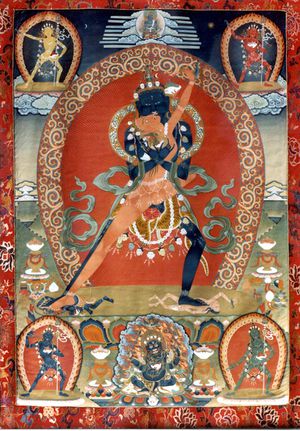Difference between revisions of "Cakrasamvara"
Jump to navigation
Jump to search
SherabDrime (talk | contribs) m |
SherabDrime (talk | contribs) m |
||
| Line 3: | Line 3: | ||
Tib. [['khor lo bde mchog]], [['khor lo sdom pa]], [[bde mchog]] | Tib. [['khor lo bde mchog]], [['khor lo sdom pa]], [[bde mchog]] | ||
| − | A tantric deity most popular with the "[[gsar ma]]" schools of Tibetan Buddhism. He is usually depicted in union with his consort Varjayoginī. He comes in a simple five deity maṇḍala in his two-armed form and surrounded by four ḍākinīs; as well as in | + | A tantric deity most popular with the "[[gsar ma]]" schools of Tibetan Buddhism. He is usually depicted in union with his consort Varjayoginī. He comes in a simple five deity maṇḍala in his two-armed single-faced form and surrounded by four ḍākinīs; as a twelve-armed and four-faced form surrounded by sixty-two deities; as well as in several dozen different many-armed and multiple-faced forms with many retinue figures, some peaceful some wrathful. The three main lineages of Cakrasaṃvara transmission, teachings and practice, which originated with the Indian Māhasiddhas [[Luipa]], [[Drilbupa]] and [[Krishnacharya]], were all transmitted to Tibet and exist to the present day. [TSD] |
[[Category:Tantric Deities]] | [[Category:Tantric Deities]] | ||
Revision as of 07:03, 30 November 2013
Tib. 'khor lo bde mchog, 'khor lo sdom pa, bde mchog
A tantric deity most popular with the "gsar ma" schools of Tibetan Buddhism. He is usually depicted in union with his consort Varjayoginī. He comes in a simple five deity maṇḍala in his two-armed single-faced form and surrounded by four ḍākinīs; as a twelve-armed and four-faced form surrounded by sixty-two deities; as well as in several dozen different many-armed and multiple-faced forms with many retinue figures, some peaceful some wrathful. The three main lineages of Cakrasaṃvara transmission, teachings and practice, which originated with the Indian Māhasiddhas Luipa, Drilbupa and Krishnacharya, were all transmitted to Tibet and exist to the present day. [TSD]
